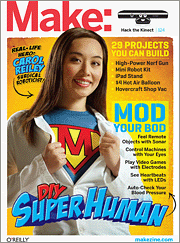
Meet Simon Jansen, a software engineer by trade who likes building all manner of odd inventions and restoring old cars in his spare time. In MAKE Volume 29, Simon wrote about making the Better Nerf Gun, a metal foam-dart gun that blows away the standard-issue plastic Nerf gun.
What’s your background?
I am 38, actually nearly 39 now, a software engineer specializing in QA and testing. I work for the New Zealand development office of a U.S. software company. I live by myself in a tiny two bedroom house with two garages! One houses my MGB (my everyday car) and space for tools and building things. In the other, I am currently building an 1937 Austin 7 sports car. The house is full of my projects, past and present. TARDIS in the living room, Bender in the spare room, half finished N-scale railway on top of the dining table (soon to go IN the dining table), creepy Steed puppet on the back of a chair. You know, usual bachelor pad type stuff. I like making things, always have.
Why do you like making things?
I’ve always been good at it and I think it’s because I have a good imagination as well as good practical skills. I can pick things up quite well. I am a bit of a perfectionist which can sometimes be annoying, but I do like to do things well. The thing I find that makes me different from non-making-things people is the thought process I go through. A lot of people ask me how did I know how to start making something. I did’t. But I reason it out. I am good at picturing in my head, not just what I want to make, but exactly how I might go about making it, too. It is something you get better with after years of practice because you will have tried (and failed) at more ways of doing things so you soon learn what will work.
Tell us about your Better Nerf Gun project
The project for MAKE came about because we were playing with NERF guns in the office. I just though well, these are cool toys, but they could surely be better. The project was my first attempt and it is better in terms of range and accuracy but not really in terms of usability. I am sure the next one I make would be better still but I have already moved onto other things!
What are your upcoming projects?
Currently I dream of the car I’m building. I have restored one car previously, but I wanted to build a car that was totally how I wanted it. Learn how to coach-build a body the way they did in the “old days.” So I am building an Austin 7. I have an expert mentoring me in how to go about it. He suggests things but doesn’t tell me what to do and rather leaves me to it. I make mistakes. I spent all day today fixing one. But I am learning a lot and really enjoying it and I think the car should end up something quite special. Or at least certainly unique! A project like this is a big, long-term one so you really do need to keep focused on it. So many people start cars, usually get as far as pulling them apart but then they never quite get them back together!
Can you tell us about one of your favorite tools?
One of my favorite tools right now is the sliding bevel. A dead simple, dirt cheap tool but when you’re trying to build a steel frame for a car and need both sides to be (roughly) the same they are invaluable! My mentor was amazed I didn’t have one already and when I bought one I was wondering why I had never got one before!
Tell me about some of the other things you’ve built.
Most of my projects are online and linked to my original website. I also have a blog of smaller projects here.
The current project that’s taking up all my time is here.

My favorite is the steam powered record player. People complain is sounds terrible but that was kind of the point. I wanted it to sound like it was powered by steam. People seem to think this was something I would use every day so it needs to be perfect but it was just a bit of fun. That project came out exactly how I wanted. Not many people got the whole taking the piss out of steampunk though.
From the pages of MAKE Volume 29:
We have the technology (to quote The Six Million Dollar Man), but commercial tools for exploring, assisting, and augmenting our bodies really can approach a price tag of $6 million. Medical and assistive tech manufacturers must pay not just for R&D, but for expensive clinical trials, regulatory compliance, and liability — and doesn’t help with low pricing that these devices are typically paid for through insurance, rather than purchased directly. But many gadgets that restore people’s abilities or enable new “superpowers” are surprisingly easy to make, and for tiny fractions of the costs of off-the-shelf equivalents. MAKE Volume 29, the “DIY Superhuman” issue, explains how.
Related articles
- Build a Better Nerf Gun (makezine.com)
ADVERTISEMENT











